The comic book adaptation Scott Pilgrim vs. the World came out in 2010 and in re-watching it (yet) again, this time employing an oppositional gaze, I was reminded of the reasons I have loved it for nearly a decade, but I was also reminded of all of the reasons why it is important it be viewed with an oppositional gaze or at the very least, a critical lens. 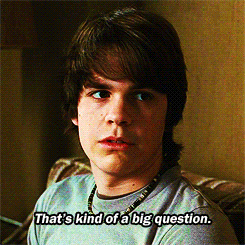
If you have not yet indulged in the comic book movie adventure, with visual onomatopoeia and commentary and a (WHITE) cast composed of now extremely well-known actors that is Scott Pilgrim vs. the World I will warn you there will be spoilers throughout the remnants of this essay (all for contextual purposes). Scott Pilgrim follows Scott, an awkward 22-year-old trying to navigate this awkwardness within his love life. Scott then goes on to battle the seven evil exes of his new object of desire, Ramona, so he can win her as his girlfriend; he must defeat them if he is to date her.
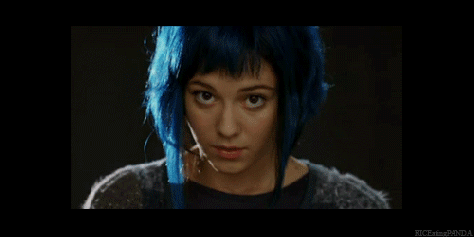
In this essay by employing an oppositional gaze and utilizing various psychoanalytic feminist perspectives from Laura Mulvey’s essay “Visual Pleasure and Narrative Cinema”, I will highlight how Scott Pilgrim vs. the World trivialized the dangerousness of an abusive relationship by using woman as an object of gaze and desire for man and placing her in a position of off-limits so that male viewers can resonate with Scott as he fights to win her for himself.
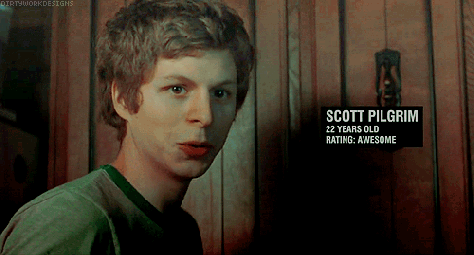
One important dynamic of this film that I have yet to mention is that of Knives Chao. While not the direct focus of this thesis, I still feel it’s important to recognize her role in this film with a female oppositional gaze and how she further develops active looking and protagonist identification in male viewers.
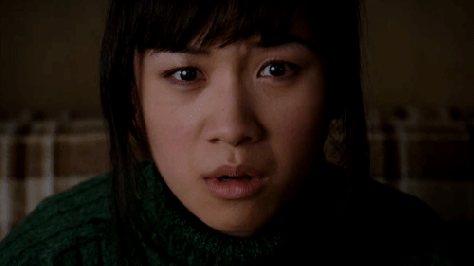
Not only is she the only non-white character (besides her briefly shown best friend and one ex (whose role is also brief)), she is the 17-year-old Scott is dating at the movie’s open. The movie itself acknowledges the stereotypical trope Knives portrays of a young, innocent, Asian school uniform girl, unknowledgeable about the world. She falls hard for Scott who ultimately ends up cheating on her with Ramona. Knives’ role as object varies throughout the movie. Significantly, she is the object of Scott’s sexual desire until another woman becomes the new one. We watch how Knives’ actions once adored by Scott quickly turn to perceptions of annoyance and uncomfortableness though only after having found his new desire of Romana. Knives’ presence in the film, as Mulvey explains, a woman’s visual presence in the film, “…tends to work against the development of a story line, to freeze the flow of action in moments of erotic contemplation” (Mulvey 33). Knives’ heartbreak spurs her desire to win Scott back and gain vengeance on Ramona, but she does this by slowly transforming herself to look more and more like Ramona as she schemes, as Ramona is clearly the object of Scott’s desire. Knives freezes Scott’s and the male viewers story line of triumph in winning Ramona with her presence once her “to-be-looked-at-ness” (Mulvey 33) in the film was transferred to a white woman.
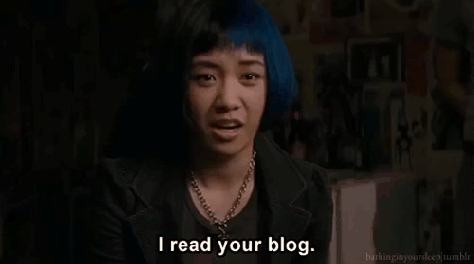
In continuing with more direct focus on my thesis, some more context is required to understand what exactly Scott must do to win Ramona. After beginning to fall for each other the first battle begins, without even Scott really understanding what’s happening. Matthew (our other non-white character) arrives and proclaims his position as Ramona’s first evil ex before their battle ensues.

Upon clarification Ramona explains this is true with little detail as to why.

Skip ahead to five battles later (one of which super problematically addresses the above quote, when Scott’s forced to fight Ramona’s ex-girlfriend, a relationship she promptly dismisses as being just a “bi-curious” phase) we learn why Scott is forced to fight all of these exes to obtain Ramona as his girlfriend.
Gideon, is number seven of the evil exes. Early in the movie Gideon comes up and we learn that leaving him behind was the reason Ramona came to town in the first place, but not much else. When we finally meet Gideon, it is right after a slight riff between Ramona and Scott, we see Gideon talking with Ramona. To Scott and male viewers for whom she is the object of desire, this scene being the first unveiling of her brand new green hairstyle, she appears to be receptive and just slightly reciprocal of his flirtation/seduction, despite her actions that more so mimic compliance out of fear. Quickly after, Ramona tells Scott she cannot date him, that she must be with Gideon. Stuttering saying “I just can’t…I just can’t help myself around him”. To someone for whom Ramona is the object of desire it’s easy to ignore the toxic language used by Gideon and the way it impacts Ramona’s behaviors.
Viewing with an oppositional gaze as a white woman and as someone who has experience with toxic relationships, it’s easy to see that Ramona is trapped within her own. It’s then learned that it was Gideon who formed the league of seven evil exes. With an oppositional gaze as a female, this indicates an abusive power dynamic between Gideon and Ramona, making him a subtle enemy to Ramona all women while to Scott and male viewers this makes him an enemy competing for their object of desire. By employing more of Mulvey’s psychoanalytic feminist perspectives, it’s possible to observe how the male unconscious tries to escape castration anxiety in this situation by “the devaluation, punishment, or saving of the guilty object” (Mulvey 35). Ramona still serves as object to Gideon as he devalues and punishes her for being the source of both his desire and anxiety, forcing her close, and still serves as object to Scott who believes he can still win her for his own. This is significant in seeing how the abusive relationship is trivialized through this pure objectification. When we assume that male viewers are taking active pleasure in viewing the same woman as object as the male protagonist Scott, we know that Ramona’s well-being and safety is not the question they’re preoccupied with for the rest of the film; rather it is will they be able to be triumphant and obtain their object?
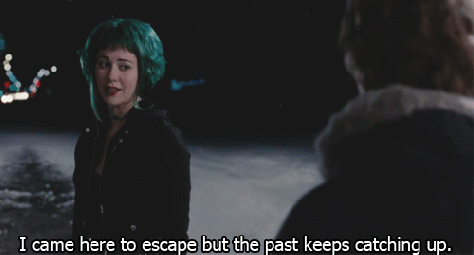
In the scripted sense there does need to be some sort of outcome that may directly or indirectly the answer male viewers question, in other words how will the protagonist they’ve been identifying with, Scott, end up? I will now focus on Scott’s final battle against Gideon and how Ramona isn’t able to play a part nor have a say in her own liberation from an abusive relationship save for one physical action. In this last battle, which focuses on Scott finding his sense of confidence and utilizing it to obtain his intense desire of possession gives him endless dramatic fight shots. After one dramatic blow, Ramona softens her expression and puts her arms around Gideon. He says arrogantly “Yeah. Still my girl” with a smirk” before Ramona says “Let’s both be girls” and kicks him in what he cares about most, only before of course he slaps her and she falls again, this time literally to his feet at the bottom of the stairs. Even when a woman’s desire in film is to liberated from abuse and fear, as Mulvey states “women’s desire is subjected to her image as bearer of the bleeding wound, she can exist only in relation to castration and cannot transcend it” (Mulvey 29). In the end it is Scott of course who defeats Gideon, meaning finally he has reached the top of the hill he has been climbing to reach his object of desire (even though she’s still laying on the ground below them).

I will not explicitly state what occurs finally between Scott and Ramona. However, I will state that the male viewers taking active pleasure in looking throughout this film, for whom Ramona too was their object of desire for 113 minutes (minus the few where Knives was object) likely left the theater feeling triumphant, not because Ramona was finally safe, not even because there was success in the physical battles, but because the object of their sexual desire was finally obtained.
Mulvey, Laura. “Visual Pleasure and Narrative Cinema.” Feminisms, 1975, pp. 28–40.


